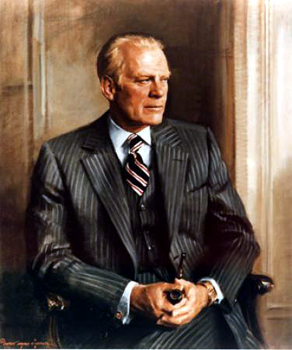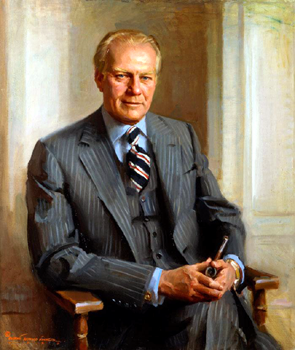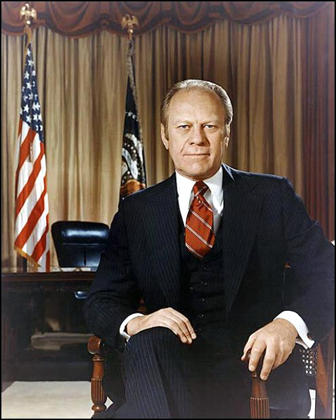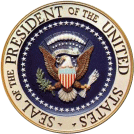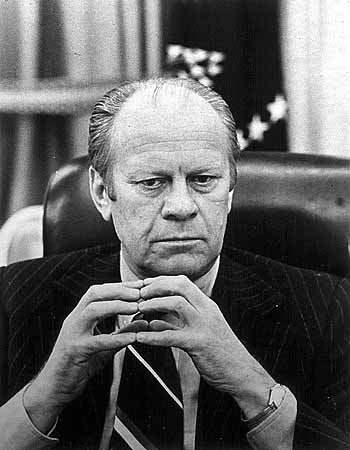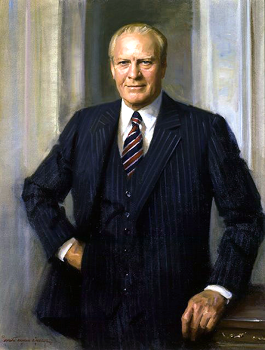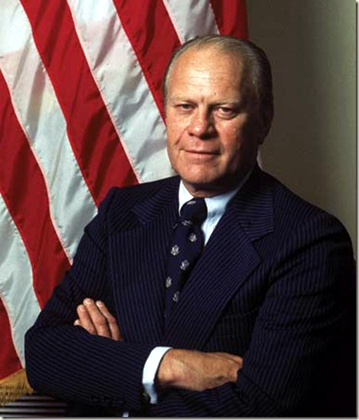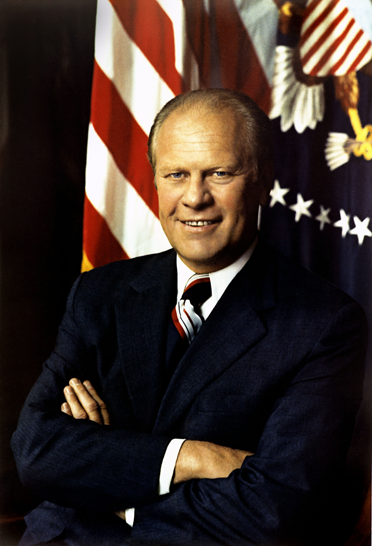|
GERALD R. FORD |
|
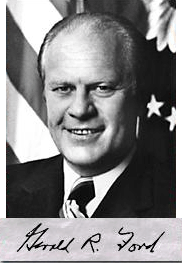
THE 38TH PRESIDENT OF
THE UNITED STATES OF AMERICA
(1974-1977)
FORD, Gerald R(udolph)
(1913–2006), 38th president of the U.S. (1974–77). The only president who was elected neither to the presidency nor to the vice-presidency, he attempted during his 2 1/2-year term to restore the nation’s confidence in a government tarnished by the Watergate scandal.Ford, whose original name was Leslie King, was born on July 14, 1913, in Omaha, Nebr. His parents were divorced, and his mother, Dorothy Gardner (1892–1967), moved to Grand Rapids, Mich., where she married Gerald R. Ford (1889–1962), who adopted her son and changed his name to Gerald R. Ford, Jr.
Ford entered the University of Michigan in 1931; he played varsity football on the undefeated 1932 and 1933 teams and was named the most valuable player in 1934. He attended Yale Law School from 1935 to 1941. After graduating and practicing law in Grand Rapids for a few months, Ford enlisted in the navy and saw action in the South Pacific. He was discharged in 1946. Two years later he married the professional model and dancer Elizabeth Bloomer (1918– ).
In 1948 Ford was elected to the U.S. House of Representatives. During his tenure there (until 1973), he was a strict conservative, opposing federal aid to education and housing, increases in the minimum wage, Medicare, the Office of Economic Opportunity, and antipollution bills. In 1970 he led an unsuccessful attempt to impeach the liberal Supreme Court Justice William O. Douglas. Ford favored increasing the defense budget, and he usually voted for civil rights legislation. In 1965 he was elected minority leader of the House of Representatives.
The Presidency.
Following the resignation of Vice-President Spiro T. Agnew in 1973, Ford was chosen as his successor by President Richard M. Nixon. During his nine months as vice-president, Ford staunchly defended Nixon, who was accused of misconduct in the Watergate affair. When Nixon resigned under threat of impeachment on Aug. 9, 1974, Ford was sworn in as the new president. One of his first and most controversial acts was to pardon Nixon for all federal crimes he might have committed in office.
Domestic Policy.
At home, Ford faced three major problems: rising inflation, unemployment, and energy use. He tried to control inflation by restricting spending for social programs—he vetoed more than 50 bills—and by attempting to win public support for a campaign known as Whip Inflation Now (WIN). During his two and a half years in office, the annual inflation rate dropped from 11.2 to 5.3 percent.
To attack unemployment, which in early 1975 was near 9 percent (the highest since the Great Depression of the 1930s), Ford tried to create jobs by cutting the taxes of upper-income people so that they would buy more goods. He resisted demands for government-sponsored public works projects to create jobs. In the energy area, he supported corporate development of new energy sources with government subsidies.
Foreign Policy.
In foreign affairs, Ford and his secretary of state, Henry Kissinger, continued the policy of détente with the Soviet Union begun under Nixon. In 1975, the U.S. signed the Helsinki Agreement, which ratified post-World War II European borders and supported human rights.
The 1976 Election.
In 1976 Ford defeated Ronald Reagan for the Republican party presidential nomination, dropping his vice-president, Nelson Rockefeller, in favor of Senator Robert Dole (1923– ) of Kansas. Ford and Dole campaigned against Democratic party nominees Jimmy Carter and Walter Mondale, but lost the election by a margin of 241 electoral votes to 297. Ford, although he was the first incumbent president to be defeated since Herbert Hoover in 1932, remained influential in Republican circles after he left office. He received the U.S. Presidential Medal of Freedom in 1999.
Assassination attempts.
Ford faced two assassination attempts during his presidency, occurring within three weeks of each other and in the same state; while in Sacramento, California, on September 5, 1975, Lynette "Squeaky" Fromme, a follower of Charles Manson, pointed a Colt M1911 .45-caliber handgun at Ford. As Fromme pulled the trigger, Larry Buendorf, a Secret Service agent, grabbed the gun and managed to insert the webbing of his thumb under the hammer, preventing the gun from firing. It was later found that, although the semi-automatic pistol had four cartridges in the magazine, the weapon had not been chambered, making it impossible for the gun to fire. Fromme was taken into custody; she was later convicted of attempted assassination of the President and was sentenced to life in prison; she was paroled on August 14, 2009 (2 years and 8 months after Ford's death)
In reaction to this attempt, the Secret Service began keeping Ford at a more secure distance from anonymous crowds, a strategy that may have saved his life seventeen days later; On September 22, 1975, as he left the St. Francis Hotel in downtown San Francisco, Sara Jane Moore, standing in a crowd of onlookers across the street, 40 feet (12 m) away, pointed her .38-caliber revolver at him. Moore fired a single round but missed because the sights were off. Just before she fired a second round, retired Marine Oliver Sipple grabbed at the gun and deflected her shot; the bullet struck a wall about six inches above and to the right of Ford's head, then ricocheted and hit a taxi driver, who was slightly wounded. Moore was tried and convicted in federal court, and sentenced to life in prison. She was paroled on December 31, 2007, having served 32 years. (It was more than a year after Ford's natural death.)
Post-Presidential years.
After his presidency, Ford joined the American Enterprise Institute as a distinguished fellow. He founded the annual AEI World Forum in 1982. Ford was awarded an honorary doctorate at Central Connecticut State University on March 23, 1988.
After leaving the White House, Ford and his wife moved to Denver, Colorado. Ford successfully invested in oil with Marvin Davis, which later provided an income for Ford's children.
Death and legacy.
Ford died on December 26, 2006, at his home in Rancho Mirage, California, about 130 miles east of Los Angeles, of arteriosclerotic cerebrovascular disease and diffuse arteriosclerosis. His age at the time of his death was 93 years and 165 days, making Ford the longest-lived U.S. President. On December 30, 2006, Ford became the 11th U.S. President to lie in state. The burial was preceded by a state funeral and memorial services held at the National Cathedral in Washington, D.C., on January 2, 2007. After the service, Ford was interred at his Presidential Museum in Grand Rapids, Michigan.
Ford died on the 34th anniversary of President Harry Truman's death, thus becoming the second U.S. President to die on Boxing Day. He was the last surviving member of the Warren Commission. His wife, Betty Ford, died on July 8, 2011. Like her husband, Betty also died at age 93. They are the longest lived Presidential couple.
The State of Michigan commissioned and submitted a statue of Ford to the National Statuary Hall Collection, replacing Zachariah Chandler. It was unveiled on May 3, 2011 in the Capitol Rotunda. On the proper right side is inscribed a quotation from a tribute by Thomas P. "Tip" O'Neill, Speaker of the House during Ford’s presidency: "God has been good to America, especially during difficult times. At the time of the Civil War, he gave us Abraham Lincoln. And at the time of Watergate, he gave us Gerald Ford—the right man at the right time who was able to put our nation back together again." On the proper left side are words from Ford's swearing-in address: "Our constitution works. Our great republic is a government of laws and not of men. Here the people rule."
